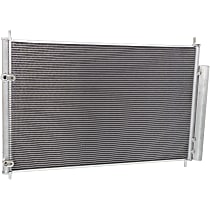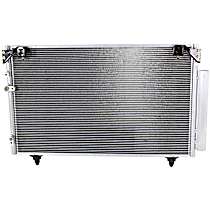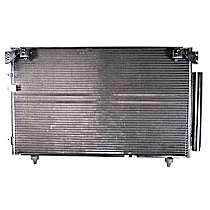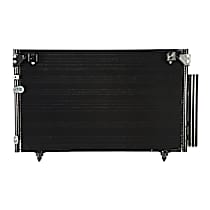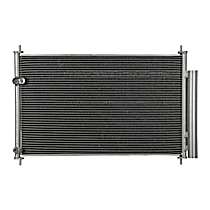Scion tC A/C Condensers
Shop Catalog
![]() WARNING: This product can expose you to chemicals including Chromium, Lead and lead compounds, which is known to the State of California to cause cancer and birth defects or other reproductive harm. For more information go to www.P65Warnings.ca.gov.
WARNING: This product can expose you to chemicals including Chromium, Lead and lead compounds, which is known to the State of California to cause cancer and birth defects or other reproductive harm. For more information go to www.P65Warnings.ca.gov.
![]() WARNING: This product can expose you to chemicals including Chromium, Lead and lead compounds, which is known to the State of California to cause cancer and birth defects or other reproductive harm. For more information go to www.P65Warnings.ca.gov.
WARNING: This product can expose you to chemicals including Chromium, Lead and lead compounds, which is known to the State of California to cause cancer and birth defects or other reproductive harm. For more information go to www.P65Warnings.ca.gov.
![]() WARNING: This product can expose you to chemical which is known to the State of California to cause cancer and birth defects or other reproductive harm. For more information go to www.P65Warnings.ca.gov.
WARNING: This product can expose you to chemical which is known to the State of California to cause cancer and birth defects or other reproductive harm. For more information go to www.P65Warnings.ca.gov.
![]() WARNING: This product can expose you to chemical which is known to the State of California to cause cancer and birth defects or other reproductive harm. For more information go to www.P65Warnings.ca.gov.
WARNING: This product can expose you to chemical which is known to the State of California to cause cancer and birth defects or other reproductive harm. For more information go to www.P65Warnings.ca.gov.
![]() WARNING: This product can expose you to chemical which is known to the State of California to cause cancer and birth defects or other reproductive harm. For more information go to www.P65Warnings.ca.gov.
WARNING: This product can expose you to chemical which is known to the State of California to cause cancer and birth defects or other reproductive harm. For more information go to www.P65Warnings.ca.gov.
![]() WARNING: This product can expose you to chemical which is known to the State of California to cause cancer and birth defects or other reproductive harm. For more information go to www.P65Warnings.ca.gov.
WARNING: This product can expose you to chemical which is known to the State of California to cause cancer and birth defects or other reproductive harm. For more information go to www.P65Warnings.ca.gov.
![]() WARNING: This product can expose you to chemical which is known to the State of California to cause cancer and birth defects or other reproductive harm. For more information go to www.P65Warnings.ca.gov.
WARNING: This product can expose you to chemical which is known to the State of California to cause cancer and birth defects or other reproductive harm. For more information go to www.P65Warnings.ca.gov.
Top Rated Products
Popular Products
Customer Guides
Troubleshooting Common Scion TC A/C Condenser Problems
The Scion TC A/C condenser receives high pressure, hot refrigerant from the compressor, which is then cooled by the condenser. But if the A/C condenser is damaged, the entire A/C system will not work properly. Below are common A/C condenser problems and solutions that you need to know:
Frozen A/C condenser
The condenser isn't supposed to be cold, much more, frozen. So if it is covered with frost, suspect a problem. A good sign that the condenser may be frozen is when the A/C doesn't blow cool air in the car cabin. When this happens, step out of the vehicle and check the condenser. If there's ice around the condenser, suspect an internal blockage. The blockage is caused by dirt, oil, and other contaminants that have accumulated over time. What you need to do is to hose down the condenser to flush the debris or replace it with a new A/C condenser. Once the condenser is cleaned or replaced, the A/C should work normally.
Leaking or damaged A/C condenser
If the A/C condenser is punctured or damaged, the liquid inside the evaporator coil may leak and cause the A/C not to blow cool air. There are two ways to diagnose the problem. First is to use an electronic leak detector. Check the low-pressure service port by connecting the blue hose of the A/C gauge set and the high-pressure service port by connecting the red hose of the A/C gauge set. Refer to the service manual of your vehicle to check if there pressure reading is correct. Make sure that you understand and follow all the safety instructions when repairing the vehicle to prevent injury. The second way is to use a refrigerant leak detector dye. Pour one can of refrigerant with lead detector dye on the low-pressure side while the engine is running and the A/C at the highest setting. Drive the vehicle for 15 minutes, keeping the A/C at the "MAX." The leak should be visible as the traces of the dye flows out of the condenser. You may plug the leak if permanent fix is not yet possible, but make sure that you replace the damaged A/C condenser right away to prevent future problems.
Just like any part of the car, it is difficult to determine exactly how long the Scion TC A/C condenser will last, but there are factors that affect the life of the A/C condenser and other components of the A/C system, particularly the way you maintain your condenser. Sure, it may take years before you experience an A/C problem on a brand new TC, but might not be the case if you don't take time to perform the following maintenance procedures:
Flush or replace the clogged condenser.
One function of the A/C condenser is to catch the excess debris thrown by the compressor during the course of its operation. Over time, the condenser gets dirty and the oil trapped in the condenser can affect the entire A/C system. If the A/C condenser is ill maintained, it will result in compressor failures. You have two options to prevent this: one is to flush the condenser and free it from sludge and contamination, two is to replace the condenser and other affected parts such as the hose, to get rid of the problem entirely. Flush the condenser when necessary.
Clean the condenser regularly.
Cleaning the A/C condenser isn't hard. All you need is a garden hose with a steady stream of low pressure water and you're ready to clean it. You may remove the fan to gain better access to the A/C condenser. Hose down the condenser to remove the debris from it. Use a soft brush to thoroughly clean the fins. In some cases, grass and weeds grow around the condenser unit, restricting the airflow. Remove them at once.
Protect the condenser during winter.
To prevent ice damage and leaf blockage, protect the condenser with a condenser cover during the fall and winter seasons.
Maintain the A/C system properly.
The condenser is just part of a bigger A/C system that has several parts working as one to provide the passengers their creature comforts. If one fails, say the compressor, then everything is worthless. So whenever you clean the condenser, check other parts of the A/C system as well. This way, you'll prevent future A/C problems and minimize repair and replacement cost.
